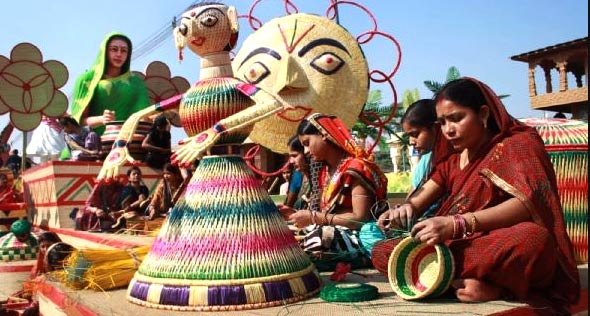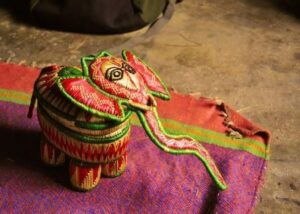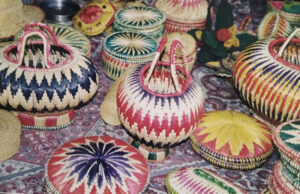Sikki craft: Art made of golden grass in Bihar
Every day at about 10 am, Munni Devi of Raiyam village in Bihar’s Madhubani district sits alongside a pile of Sikki, a golden-hued grass that grows in the wet and marshy areas around rivers and ponds in the state. Her deft fingers weave the pliable grass into an organic and biodegradable toy tiger, which will travel to the nearby cities soon. A Delhi-based supplier has placed an order for Sikki toys, which will keep Devi busy for many days to come.
In Bihar’s capital Patna, every day for a week now, Jeevan Singh, a 25-year-old Sikki artist, cuts the dried golden grass into triangular and diamond shapes and thin strands using a surgical blade. He pastes them on black paper to make a wall hanging portraying Lord Buddha sitting under the Bodhi tree. The framed wall hanging will adorn the home of an art lover in Mumbai.
Both Devi and Singh are Sikki artists and are working day and night to make sure that the order they have received gets delivered on time. Bihar’s Sikki folk handicraft, which traces its origin to the Vedic period, has got a new lease of life as artisans are not only contemporising the designs but also the art form itself.
The craft of Sikki weaving is a perfect example of sustainability in contemporary times, according to the artists. “These grass products are lightweight, organic, biodegradable and last just as long as you would like them around,” says 52-year-old Devi.
How grass turns into craft
Sikki craft has minimal requirements, according to artist Devi. Sikki, which grows during the monsoon season, is harvested along with other grains. It is split into two and left to dry for 20-25 days. Upon drying under the sun, grass attains its signature golden hue.
The resulting fine golden fibre is used in weaving to make toys, dolls, and dolchi (baskets). Artists use the grass in its natural colour or dye it into vibrant hues of purple, magenta, green, and bright yellow. For dyeing, Sikki is put in boiling water to which natural food colour is added. “These basic colours are easily available in the local market. The grass absorbs the colour after boiling for about 15-20 minutes. It is then washed and dried. Sikki is then ready for use,” Devi points out.
Each Sikki product starts with a base frame called Munj, as per the design. Then the Sikki strands with a 6-inch long needle-shaped tool called Takua are woven around it. Takua has a rounded head for a comfortable grip, which is usually made of wood or lacquerware. To split the Sikki strands, a very fine knife or a pair of scissors called are used.
Water is used to moisten the grass, which makes it more pliable to turn it around the Munj structure. The coiling is done so finely that the Munj base is not visible at all. Hands constantly play with multicoloured Sikki laces, till the artist is satisfied with the emerging pattern and its finish.
“Earlier people, especially women, would create dolls, containers, toys, storage boxes, bangles and other articles with the grass. Grains were stored in Sikki containers and young girls were judged based on their skill in the art,” explains Devi.
Market for the handicraft
Singh, Sikki artist from Patna, says that the craft is no longer limited to villages or to making items of daily use. “Its scope has become as wide as one’s imagination! I have made a 10-feet mango tree on order and a four-feet elephant for sending it to London last month,” he says.
The fact that the Sikki items are eco-friendly adds to their popularity. Not surprisingly, the art is travelling globally, thanks to online platforms like Okhai, Amazon and many other vendors, who are selling a range of Sikki products.
That is why thousands of women, and now even men, in Madhubani, Sitamarhi, Rampur and other places in Bihar are creating Sikki artefacts to cater to the growing market in India as well as overseas.
“We work with wholesalers who supply our Sikki handicrafts to buyers within India as well as London, Paris and other places,” says Devi.
Emerging new artists
With increasing options to sell products, especially online, many artists are getting drawn to the craft. Jogira India Foundation in Patna, established by Sunni Gupta, a NIFT Patna alumnus, is among organisations working to revive the folk arts of Bihar, especially Sikki.
It has employed around 200 artists in the state. Suriya Kumar, a 28-year-old artist who hails from Begusarai, says he came to know about Sikki six years ago when he was trying to learn Madhubani painting.
“It instantly caught my eye and soon I became a full-time Sikki artist. The art is time-consuming but it pays off. Many people are interested in buying these artefacts. I am excited about appearing at the state level competition,” says Kumar.
Devi says many women in her own village are now practising the craft. “I have also trained about 100 girls in Sikki as youngsters are now showing an inclination towards learning and earning from the craft. No doubt that the Sikki has been called the ‘golden grass’ of Bihar and I hope the golden days of Sikki to return as new artists take it upon themselves to revive, create and popularise this craft,” adds.












